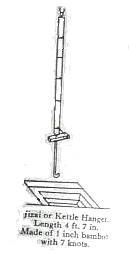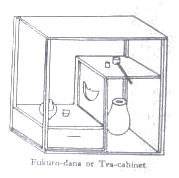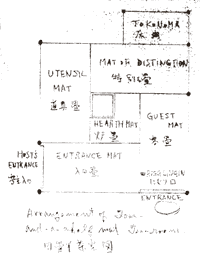KAKOI AND SUKIYA
囲いと数寄屋
The Tea-room is called sometime Kakoi and sometime Sukiya.
茶室は時として囲いまたは数寄屋と呼ばれることがあります。
Of these words the former has the meaning of "Enclosure", and signifies a portion of a larger room enclosed by a screen in a square from of four and a half muts or more in which Cha-no-yu was given according to the original manner.
この言葉はまさに囲うと言う形から来ていて、大きな広間を四畳半に布で区切って使う意味になります。又、茶の湯事態が独特のマナーであると言う意味かもしれません。
This is still done in a house where there is no regular Tea-room.
家屋の中にはまだ茶室がなかったのです。
Sukiya, on the other hand, denotes a special room separated from the main house, or sometimes attached to it as a lean-to, and its meaning is more * complicated.
数寄屋は母屋から分かれた特別な部屋や、また茶の湯を稽古するための場所だったりし、説明はとても難しいかもしれません。
Taking it in the plain sense of the characters used to write it namely, "Kazu wo Yusuru (to bring together a number of objects," it may be explained as referring to the acquisitive collectors spirit of the early Tea Masters.
その特質的、明瞭な感性で茶室をもつことは、いいかえれば、「数を有する」ということで、初期の茶人達の貪欲な所有欲についてを説明しているものと思われます。
Ikkyu, however, takes the second character Ki in the sense of Kimyo (wondrous), when it would mean "Many wondrous things, " according to an observation that he made to Shuko that "Cha-no-yu is in harmony with the wondrous way of Budda, for it utilises the marvellous working of the Universal Mind."
一休もまた、奇妙と言う精神を奇としてもっていました。「すべてが奇妙」Shukoの書いたものを引用しています。「茶の湯は仏様の奇妙な修行とハーモ二ーを持ち、そして、一般的な精神構造のなかで不思議な作用として有益である」
By others this syllable Ki is taken to mean "Odd", in the sense that Teaism is associated with what is odd and not even, since it dislikes the complete and prefers the imperfect.
別の意味において奇と言う言葉は「おど」と言う言葉もあわせもっています。茶ではおどと言う意味は若干のちがう意味を有し、完璧をこのまず、むしろ不完全な美とでも言うべきでしょうか。
Again the word Suki may be regarded as the equivalent of "Tashinami," "Taste," thus signifying those who have tasteful feeling generally, then applied in a particular manner to those who liked Tea.
もう一度数奇と言う言葉を考えるとき、「たしなみ」「あじわい」と言うような意味あいをもっていると思います。それは茶の湯の中の特別なマナーみたいなものです。
This is the view of an older work on the subject, the Roji Chosho, but a more modern writer thinks the sense of " Oddness" is best, and certainly "Suki" is explained as meaning "Uneven" in passages where it occurs in the Chinese classics.
これは主題における一つの古い仕事の外見です。Roji Chosho、よりモダンな著者はOddnessの感性と考え一番だと言っています。Sukiとは中国古典に見られる所のUnevenを説明しているのです。
So the Tea devotee is one who finds his interest in spheres that are apart from the ordinary spheres of life and "remote from the dust of this world."
そして、茶の愛好者は露地と言う領域の中で自分自信の大切なものを発見します。その領域とは、普段の生活から離れた世界、世俗からの隔離を意味します。
There is a certain addness about him as well as his Tea-room.
彼ら茶人にとって茶室と同じくらい心底得るものがそこには存在します。
Its situation should not be specially chosen, neither should any roughness in its eaves or windows, or lack of symmetry in its posts cause the owner any uneasiness.
ひさしや窓が粗野にできていると言うことはなく、家主の迷いのない柱のつりあいの欠如、これは特別な選択の中ではないのです。
All he should think about is the equilibrium of his mind, and however great or distinguished his visitor may be, he must forget all his magnificence and put off for the time the better of the world to which it belongs and become a "guest above the clouds."
その目的は心の平静にあり、多分荘厳なそして訪れる客の選別かもしれません。彼らの権威やその世界の足かせを取りのぞき、、まさに雲の上の客として迎えるためなのです。
Rikyu would not permit those in a humble position to show any deference in the Tea-room for he said, "In the Sukiya and its garden (Roji) there are but Host, Guest and Tea."
利休は「数寄屋とその露路は亭主、客、茶のみがある」といいました。茶室の中の別次元を低い地位の人たちへは許可しなかったかもしれません。
Shuko`s Tea-room called Shuko-an is termed the "Formal" style to distinguish it in the usual way from the "Informal" and "Intermediate".
珠光の茶室は珠光庵と呼ばれ、正式なものとされています。一般的なものやその中間のものとは区別されているのです。
It was of four and half mats and the walls were covered with egg-shell coloured paper, the ceiling being of narrow boards of knotless cedar and the Tokonoma six feet wide.
その茶室は四畳半で卵の殻色の紙によって壁が作られ、天井は杉木の節目のない幅の狭い木でできています。そして床の間は6フィート(約180cm)の幅があります。
Later on a hearth a foot and a half in diameter was cut in the floor and a kettle called "Flat Spider" used with it , the shelf called k Kyudai Daisu holding the utensils.
そして、直径が約1フィート半(四寸、42cm)ほどの炉が切られており、平蜘蛛釜というヤカンが置かれています。隣には及台子と呼ばれる道具を飾る棚があります。
On the walls of this room there are said to have been black-and-white sketches by Engo Zenji, while in the Tokonoma either a single picture or a set of two was displayed.
壁には園悟禅師の墨跡がかけられています。床の間と言い、一つ飾る時と二つ飾る時があります。
In front of this was a stand with an incense burner and a flower vase, either of the ordinary sort of a small one with a single flower.
掛軸の前には香炉という香りを炊く容器と花瓶が置いてあり、そして小さな一輪の花が差してあります。
Boxes for stationary and Tanzaku or poemslips, inkstone and bookstand, a tray-garden and jars for leaf-tea are also mentioned, so that it is evident that this Tea-room was much like a ordinary study in its furnishings and not specialised as afterwards.
短冊や硯の入った箱や本立、箱庭や葉茶のポットなども記載されています。すなわち、茶室と言うのは学場所でありその為の備品が備えられたところ、特別ではないと言うこと現しているのです。
Sho-o went a step further and made a Tea-room pf the same size but had the walls plastered instead of papered and used bamboo for the lattice window instead of wood.
紹鴎はそれを更に進めて茶室を作りました。茶室そのものの大きさはそのままに紙のかわりにしっくいの壁にして、木のかわりに竹を格子窓に使用したのです。
Hence it was that Shuko`s style was called Formal and Sho-o`s Informal.
その後、珠光式を正式なものとし紹鴎式を正式ではないものとなりました。
The latter used a kettle suspended by a chain and arranged his utensils on a Fukurodana or Tea-cabinet.
紹鴎は釜を鎖でさげて袋棚と言うキャビネットへ道具類を飾りつけました。
So he may be said to have come nearer to the unadorned simplicity of Vimalakirti in his meditation hut.
彼は多分瞑想の庵としてVimalakirtiの装飾のない簡素なものに近づけたかったのだと思います。


The next impulse was due to Rikyu, who was dissatisfied with the air of luxury and complexity that had come to surround the Tea-room and its furnishing, and who therefor designed a two-mat Tea-room after consultation with his masters Sho-o.
続いての推進は利休によってなされました。彼は道具や茶室回りの贅沢さや複雑さにまだまだ不満で、師である紹鴎と相談して二畳の茶室を作ったのです。
This was the beginning of "Roji Teaism", as it was called from yhe guests entering the Sukiya by way of the "Roji" or Dewy path.
これは露地の茶の始まりで、客が露地をぬけ草庵へ入っていく流れを作ったのです。
In these days, however, there was no Machiai or Arbour fir the guests to rest in befor entering the Tea-room.
それまでは茶室に入る前に客が待つ場所、樹陰の休憩所のような待合と言うものはなかったのです。
The first Machiai was that built by Kanamori Izuminokami Arishige to entertain Hidetada at his mansion opposite Toranomon.
最初の待合がそれじたい建てられたのは、金森出雲守可重が秀忠公を虎の門の向かいの彼の屋敷で接待したのが最初です。
After the death of Rikyu the direct tradition of his house came to end for a while, since when the master is under a cloud the disciples generally go elsewhere.
利休没後、その建築様式の伝統はしばらくの間とだえました。その間かれの門弟達はあちらこちらに分散していくことになるのです。
But Sokei handed it on and it is to him that we owe our knowlede of what Rikyu taught.
しかし宗啓は利休から教えられた知識を広く残すことが大切であると感じました。
Sokei was a priest of the Shu-un-an at the temple of Nansoji at Sakai, hence his usual designation Nanbo Sokei.
宗啓は堺の南宗寺にある集雲庵の僧侶でしたので、それゆえ彼を南坊宗啓と呼んでいます。
Of him Rikyu said, "If after my departure, there is anyone among my descendants who wishes to understand Teaism let him become the pupil of Sokei."
利休は彼について言っています「もし私がこの世を去ったら私の子孫のなかで茶の湯の道を志す者は宗啓の弟子となる」
His work the Nambo Roku in wich the traditions of the Sen house are recorded together with the diary of Rikyu's Cho-No-Yu meeting for a year, has lately been reprinted in six volumes, and is a most valuavle text.
宗啓は南坊録を記した人物として知られています。千家の茶の湯の日常を記録し、後七巻の書物に収められ最も一般的なテキストとなっています。
Since the Tea-room is modelled on the pure and spotless ideal world of Buddhist meditation, all luxury and ostentation must be avaided, and especially expensive straining after simple rusticity and sending to distant provinces to get adzed wood irregularly worm-holed.
その後の茶室は仏教理念を基礎として汚れのない純粋なものをモデルとして作られ、贅沢や虚飾はもっとも避けられたのです。後に、シンプルや質素の中に、手斧で削った虫食いの木を遠い国からとり寄せると言うように希少性の高い物を使うようになったのです。
Costly affectation of simplicity as bad as obvious display of wealth, and will certainly elicit the smiles of the enlightened.
明白は富の顕示よりはむしろ見せかけの貧素がよしとされ、まさに知る人ぞ知ると言う感覚が養われました。
Rikyu used red pine with the bark on for the pillar of the Tokonoma and weathered square timber for the others.
利休は床の間の柱に皮がついたままの赤松と、周りには風化した四角い梁を使用しました。
Kobori Enshu liked a frost-mottled cryptomeria pole showing the adze marks for the former and dead chestnut wood for the latter.
小堀遠州はわざと手斧の跡をつけ、しかも、霜状に斑点の付いた日本杉や朽ち果てたトチノ木を好んで使いました。
Ordinary pine, cryptomeria, hinoki or plum in the round with the bark on will do quite well for the pillars, while for the thresholds, sills and lintels cryptomeria with a reddish tinge is very suitable.
あちらこちらにある皮のついたままのニッポン杉、ひの木や梅の木、松は柱に使用され、特に赤茶けた色合いのニッポン杉は敷居の土台の木や横木に使われるのがもっとも一般的です。
The same wood may be used for the outside shutters and entrance hatch.
同じ木は家屋の外の雨戸や入り口の戸に使われます。
Rare woods like Bonin palm are quite out of place.
ヤシに似た珍しい樹木は外に植えられています。
The importante thing about building a Tea-room is that the owner and the carpenter should thing out how best to make use of and fit in any ordinary wood that happens to be available.
重要な事は、茶室を作るとき、その主と大工が他の木々との調和をいかに道引き利用できるかにかかっているのです。
It is the suitbility to its purpose that is to be considered, and not the material.
素材の問題ではなく似合うと言う意図が重要なのです。
The measurements and dimensions on floor, alcove window and door opening, etc., have been fixed by the great Tea-Masters because of their pratical convenience and it is best to follow them.
床、床、窓や扉等々の寸歩や測定法は偉大なる茶人たちによって定められてきました。それは彼らの修練により利便性により最良部分が受け継がれて来たのです。
Any attempt to change them for the sake of individual whim or because "it would look better" or "seem more quaint" is not to be countenanced.
この決まり事は個々人の気まぐれ的な変更は皆無です、「この方が良く見える」、「変わってる」と言う理由は支持されなかったのです。

Somilarly the plaster on the walls is to be plain grey, and put on in a manner suitable to the size of the rooms.
同様に壁の色は無地のグレイで部屋の大きさに合った行儀作法をします。
There is no need to use various clours or do the works in a fussy and elaborate way.
様々な色の配色は無用、うるささや手の込んだケバケバしさはありません。
It should be renderd with simplicity and vigour so as to give a good texture, and then left alone.
簡素にして、気持ちの良い感じによって活力を刺激します。ある意味孤独への誘いかもしれません。
Too much finish is no the vulgar side.
もっともいみ嫌われるのは俗っぽいことです。
All round the bottom of the plaster the wall should be papered to the height of nine inches.
壁のしっくいの下には9インチ強の紙で覆われています。
Mino paper laid inside out should be used.
美濃紙というのが使われるのが普通です。
By the entrance from the misuya a skirting of light gray minato paper is put on one foot eight inhes high.
水屋の入り口の端の紙は明るいグレイ色のみなと紙と言うものが使われ、1フット8インチの高さがあります。
This skirting paper is a suvival of tha days when the Tea-room was built of wood simply papered over without any plaster.
茶室がしっくい等を使わずに木によって簡素に建てられた時から、この紙は使われていました。
The "fitments" (shoji and fusuma) should be as light as may be, for a tea-room is not built for strength.
障子や襖はとても軽く作ってあって、それらがけして建物の強化のために作られたのではないのが分かります。
The small window openings should have cross pieces of bamboo, the horizontals with the bark side uppermost, and the vertical rods with the bark side inwards if there is only one, and the middle one bark side inwards and the two others with it outwards if there are three.
小さな窓を開けるには竹の棒をさしかけます。横木が一番上にあり場合は一本の縦棒でささえ、中央に横木がある場合は二本ないし三本でそれを支えます。
* Rikyu and his school used fusuma with black lacquer frames, but ordinary wood is common.
利休やその社中は普通使う木の襖枠に黒い漆を塗っていました。
The fusuma in a tea-room are papered in the manner called Fukurobari, i.e. they are like shoji but with white paper pasted on both side insteard of on one side only.
茶室の襖は袋張などと呼ばれる紙が張ってあります。障子のようなものですが片方だけに紙が張ってあるのではなく、両面に紙が張りつけてあるのです。
A Tea-room should neither be too light or too dark inside.
部屋の中が明るすぎず、暗すぎず、が目的です。
A room that is too light is not suitable for concentration, for the mind is likely to be disturbed, but on the other hand if it is not light enogh a sense of gloom and melancholy may be felt, which is worse.
明るすぎる部屋は精神集中には適しませんし、邪魔もします。フェルトのような薄黒白色や薄暗闇はまた他方においてはよくありません。
The outer windows and overhung shutter must be arranged according to the position of the sun so that a happy medium can be abtained.
最適な太陽の光をとりいれるために天窓のような上に突き出た窓があります。
When the Tea-room does not form part of the main building but is built separetely there must always be a garden between it and the main house.
茶室と言う建物はその家屋全体のなかの中心的な部分ではなく、庭と居住の間に位置しています。
This must have a fence round it, and inside this fence will be the waiting arbour and the privy.
周りには壁があり、待つ為のあずま屋やプライベートが備えられています。
Beside thise will be a wash-basin.
よこには水鉢が置かれ。
From this a small gate through another fence leads to the Tea-room.
小さな戸を通って茶室へと誘導します。
This small gate which is knoum as "Sarudo" or "Monkey gate" has also a low water basin beside it on the inside.
その戸は猿戸と言う名前で呼ばれ、その内側のすぐ下には水鉢が置かれています。
INTRODUCTION-1 TITLE CONTENTS